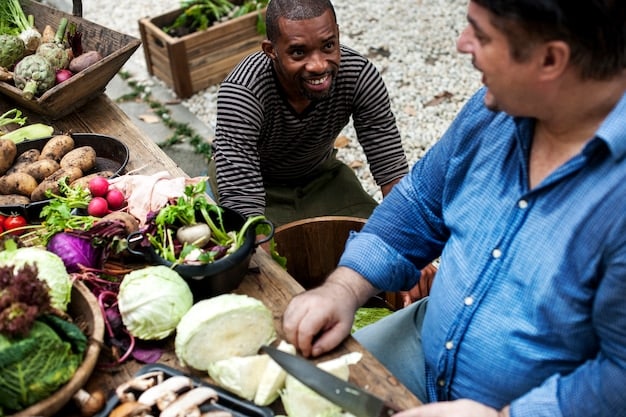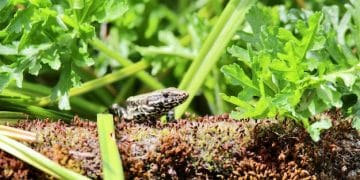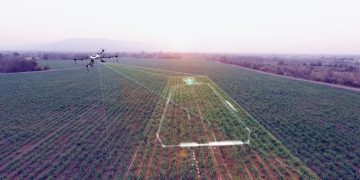Reducing Food Waste in the US: Minimizing Environmental Impact

Advertisements
Reducing food waste in the US is crucial for environmental sustainability, as it significantly minimizes greenhouse gas emissions, conserves resources, and alleviates pressure on landfills, fostering a more efficient and regenerative food system.
Advertisements
The sheer scale of food waste in the United States is staggering, presenting a complex challenge with far-reaching environmental ramifications. But how can we reduce food waste in the US and minimize its environmental impact? This question delves into a multifaceted problem that touches upon every stage of our food system, from farm to fork and beyond. Addressing this issue is not merely an economic consideration; it is a critical environmental imperative that demands a comprehensive and collaborative approach. From improving agricultural practices to redefining consumer habits, the journey to a more sustainable food future depends on our collective ability to reduce the amount of edible food that never reaches a plate.
Advertisements
Understanding the Scale and Impact of Food Waste in the US
The United States generates an astonishing amount of food waste each year, making it one of the leading contributors to landfill content and a significant source of greenhouse gas emissions. This waste occurs across the entire supply chain, from production and processing to distribution, retail, and ultimately, consumer households. The environmental consequences are profound, affecting everything from land use and water consumption to air quality and biodiversity. Recognizing the true scale of this issue is the first step toward effective mitigation strategies.
The Astonishing Numbers: How Much Food Do We Waste?
Estimates vary, but the U.S. Department of Agriculture (USDA) and the Environmental Protection Agency (EPA) suggest that between 30-40% of the food supply is wasted. This translates to billions of pounds of food annually, enough to fill 44 million Olympic-sized swimming pools. Much of this waste is perfectly edible and nutritious, highlighting systemic inefficiencies and consumer behaviors that contribute to the problem.
- Approximately 130 billion meals are wasted annually in the US.
- Up to 20 pounds of food per person per month are discarded at the consumer level.
- Retail food waste alone can account for significant losses due to aesthetic standards and overstocking.
Environmental Ramifications: Beyond the Landfill
While landfills are the most visible destination for wasted food, the environmental impact extends far beyond them. When food biodegrades in landfills without oxygen, it produces methane, a potent greenhouse gas over 25 times more effective at trapping heat than carbon dioxide. This significantly contributes to climate change. Furthermore, the resources used to produce, process, and transport this wasted food—including water, energy, and land—are also squandered, adding to environmental strain.
- Food waste is the single largest component taking up space in US landfills.
- It accounts for roughly 8% of global greenhouse gas emissions.
- Vast amounts of fresh water are used to grow food that is never eaten.
Understanding these profound figures and environmental consequences is essential for motivating change. The complexity of the issue means that solutions must be equally comprehensive, addressing various points throughout the food system to make a tangible difference. From farm to fork, recognizing and quantifying these losses empowers us to develop targeted and effective interventions.
Innovative Solutions at the Agricultural and Production Level
Reducing food waste begins at the very source: our farms and production facilities. Significant amounts of perfectly edible food never leave the farm, often due to strict cosmetic standards, market fluctuations, or pest damage. Addressing waste at this initial stage requires innovative thinking and a shift in conventional practices.
Improving Harvesting and Storage Techniques
Many crops are left unharvested in fields, a phenomenon often referred to as “ugly produce” or “cosmetic imperfections.” Consumers and retailers often demand blemish-free fruits and vegetables, leading to the discarding of perfectly nutritious food. Advanced harvesting machinery and precision agriculture technologies can help minimize losses during collection. Furthermore, optimizing storage conditions, such as temperature, humidity, and atmospheric control, can significantly extend the shelf life of produce, preventing spoilage before it reaches markets.
- Investment in sensor-based monitoring systems for cold storage.
- Training farmers on best practices for post-harvest handling.
- Development of biodegradable coatings to extend produce freshness.
Rethinking “Ugly” Produce and Direct-to-Consumer Models
A growing movement is challenging the conventional beauty standards for produce. Initiatives that embrace “ugly” or “imperfect” fruits and vegetables by selling them at a discount or incorporating them into processed products are gaining traction. Establishing direct-to-consumer channels, like farmers’ markets or Community Supported Agriculture (CSA) programs, also reduces the steps in the supply chain where food might otherwise be discarded.
- Partnerships between farms and secondary markets for off-spec produce.
- Subscription boxes featuring “ugly” but edible fruits and vegetables.
- Collaboration with food processors to turn surplus into value-added products.

By implementing these and other innovative strategies at the agricultural phase, we can significantly reduce the amount of food that never even makes it to consumers. This not only minimizes environmental impact but also fosters economic resilience for farmers and ensures more food reaches those who need it, optimizing resource utilization from the ground up.
Streamlining Supply Chains and Retail Operations
The journey from farm to fork involves multiple steps, and each transition point presents an opportunity for food loss. Supply chain inefficiencies and retail practices are significant contributors to food waste. Addressing these areas requires enhanced collaboration, improved inventory management, and a shift in consumer-facing strategies.
Optimizing Logistics and Inventory Management
Outdated inventory management systems, inefficient transportation, and a lack of real-time data often lead to overstocking and unexpected spoilage. Implementing advanced logistics software, such as predictive analytics and AI-driven platforms, can help retailers and distributors accurately forecast demand, optimize delivery routes, and ensure that food moves through the supply chain with minimal delays. Better coordination between suppliers and retailers can also prevent unnecessary surpluses.
- Utilizing AI to predict consumer demand and optimize ordering.
- Implementing “first-in, first-out” (FIFO) inventory practices diligently.
- Investing in temperature-controlled transport to prevent spoilage en route.
Retail Strategies for Waste Reduction
Supermarkets and grocery stores contribute substantially to food waste due to overstocking, stringent aesthetic standards, and approaching expiration dates. Retailers can adopt several strategies to mitigate this. Offering “imperfect” produce at a discount, donating unsold but still edible food to food banks, and optimizing display practices to avoid excessive quantities on shelves are effective approaches. Additionally, implementing clear date labeling (e.g., “best by” vs. “use by”) can help reduce consumer confusion and unnecessary discards.
- Selling slightly damaged or close-dated items at reduced prices.
- Partnering with food recovery organizations for regular donations.
- Using dynamic pricing models to sell items nearing their expiration.
By streamlining operations and rethinking traditional retail approaches, the food industry can significantly reduce its waste footprint. These strategic adjustments not only benefit the environment by cutting down on landfill contributions and resource use but also create financial efficiencies, leading to a more sustainable and profitable business model.
Empowering Consumers: Education and Behavioral Change
A significant portion of food waste occurs at the consumer level, within our homes. This waste is often a result of misunderstanding date labels, poor meal planning, impulse purchases, and improper food storage. Empowering consumers with knowledge and tools to change their habits is crucial for tackling the food waste problem effectively.
Demystifying Date Labels and Storage Tips
One of the biggest sources of consumer confusion is the array of date labels on food packaging. “Best by,” “sell by,” and “use by” dates are frequently misunderstood, leading to edible food being thrown away prematurely. Educational campaigns can clarify these labels, teaching consumers that “best by” often refers to peak quality, not safety. Additionally, providing simple, practical tips for proper food storage—like understanding which produce belongs in the fridge versus on the counter—can significantly extend shelf life at home.
- Public awareness campaigns on the meaning of food date labels.
- Digital resources and apps offering food storage guidelines.
- Workshops on techniques like freezing, canning, and fermenting.
Meal Planning and Smart Shopping Habits
Spontaneous shopping trips and a lack of meal planning often result in buying more food than needed, leading to spoilage. Encouraging consumers to plan meals, create shopping lists, and check their pantry before heading to the store can drastically reduce unnecessary purchases. Promoting the concept of “eating down the pantry” or “first in, first out” at home helps ensure older items are consumed before they expire. Batch cooking and repurposing leftovers also play a key role in minimizing kitchen waste.
- Promoting weekly meal planning templates and apps.
- Encouraging smart shopping lists based on actual needs.
- Sharing recipes that utilize common leftovers or expiring ingredients.

Empowering consumers with these practical skills and knowledge can transform household habits, significantly reducing domestic food waste. This shift not only contributes to a healthier planet but also helps households save money, making food waste reduction a win-win for individuals and the environment.
Advanced Food Recovery and Redistribution Initiatives
Even with proactive measures, some edible food will inevitably become surplus. The next critical step is to ensure this food is recovered and redistributed to those in need, rather than ending up in landfills. Food recovery organizations play a vital role in connecting surplus food with food-insecure populations and other beneficial uses.
Building Networks for Food Donation
Establishing robust networks between food donors (e.g., grocery stores, restaurants, catering companies) and food recovery organizations (e.g., food banks, shelters, gleaning groups) is paramount. Innovative digital platforms and logistical solutions can facilitate these connections, making it easier for businesses to donate surplus food efficiently and safely. Overcoming logistical challenges, such as transportation and storage, is key to scaling up these efforts.
- Developing app-based platforms for real-time surplus food matching.
- Investing in refrigerated vehicles for safe food transport to beneficiaries.
- Creating local volunteer networks for food collection and distribution.
Innovative Redistribution Models
Beyond traditional food banks, new models for food redistribution are emerging. “Rescued food” businesses transform imperfect or surplus ingredients into new products, such as snacks, beverages, or meal kits. Community fridges, where individuals and businesses can share surplus food, and “pay-as-you-feel” cafes that serve meals made from rescued ingredients, offer accessible ways to divert food from waste and feed communities.
- Startups specializing in upcycling food waste into new products.
- Community-led initiatives like public fridges and food sharing apps.
- Partnerships with universities for research into new food recovery methods.
By prioritizing food recovery and redistribution, we ensure that edible food fulfills its primary purpose: nourishment. This not only addresses food insecurity but also significantly reduces the environmental burden of food waste, showcasing a more circular and compassionate approach to our food systems.
Circular Economy Approaches: Composting and Anaerobic Digestion
Despite all efforts to prevent and recover food waste, some portion will inevitably be inedible or spoil. For this residual organic material, diverting it from landfills into beneficial uses aligned with circular economy principles is essential. Composting and anaerobic digestion are two powerful methods that transform food waste into valuable resources.
The Power of Composting: Enriching Soils
Composting is the natural process of decomposition and recycling of organic matter into a humus-rich material called compost. When food scraps are composted, they return valuable nutrients to the soil, improving soil structure, water retention, and microbial health. This reduces the need for synthetic fertilizers, lessens soil erosion, and sequesters carbon, contributing to healthier ecosystems and more resilient agricultural systems.
- Promotion of backyard composting for households.
- Expansion of municipal composting programs for food scraps.
- Development of commercial composting facilities for larger volumes.
Anaerobic Digestion: From Waste to Energy
Anaerobic digestion is a process where microorganisms break down organic materials in the absence of oxygen, producing biogas (a mixture of methane and carbon dioxide) and a nutrient-rich digestate. Biogas can be used as a renewable energy source to generate electricity, heat, or vehicle fuel, creating a closed-loop system where waste powers our infrastructure. The digestate can then be used as a fertilizer, similar to compost.
- Investment in large-scale anaerobic digestion facilities across the US.
- Policy incentives for businesses and municipalities to adopt AD technology.
- Research into optimizing AD processes for various types of food waste.
By embracing these circular economy approaches, we transform food waste from a liability into an asset. Composting and anaerobic digestion not only divert significant quantities of organic material from landfills—thus reducing methane emissions—but also create valuable resources, closing the loop on our food system and fostering a more sustainable future.
Policy and Regulatory Frameworks: Driving Systemic Change
While individual and organizational efforts are crucial, overarching policy and regulatory frameworks are necessary to drive systemic change in how food waste is managed. Government policies can incentivize waste reduction, mandate food recovery, and support infrastructure development for composting and anaerobic digestion.
Government Incentives and Subsidies
Policies can encourage businesses and consumers to adopt waste-reducing practices through financial incentives. This might include tax breaks for food donations, grants for communities developing composting facilities, or subsidies for farmers who adopt practices that minimize on-farm waste. Creating a supportive economic environment can accelerate the adoption of sustainable food waste solutions.
- Tax incentives for businesses donating surplus food.
- Funding programs for food waste reduction and recycling infrastructure.
- Grants for innovation in food preservation and valorization technologies.
Mandates and Regulations
Some states and cities have implemented mandatory organic waste diversion laws, requiring large generators of food waste (e.g., restaurants, grocery stores, universities) to separate food scraps for composting or anaerobic digestion, rather than sending them to landfills. These mandates provide a strong impetus for businesses to change their practices and invest in proper waste management infrastructure. Clear labeling standards and public reporting on food waste volumes can also increase transparency and accountability.
- Implementation of statewide organic waste bans or diversion mandates.
- Development of standardized food date labeling regulations.
- Requirements for large food generators to measure and report food waste.
Effective policy and regulatory frameworks provide the necessary backbone for a nationwide shift toward reduced food waste. By creating a supportive and, where necessary, mandated environment, governments can accelerate the transition from a linear “take-make-dispose” food system to a more circular and sustainable model, ultimately benefiting both the economy and the environment.
| Key Point | Brief Description |
|---|---|
| 🌱 Agriculture Innovation | Improve harvesting, storage, and rethink “ugly” produce to reduce farm-level waste. |
| 🛒 Supply Chain Efficiency | Optimize logistics, inventory, and retail practices to minimize spoilage and discards. |
| 🏡 Consumer Empowerment | Educate on date labels, promote meal planning, and smart storage for household waste reduction. |
| ♻️ Circular Economy | Compost and anaerobically digest inedible waste to produce valuable soil amendments and energy. |
Frequently Asked Questions
▼
While waste occurs at every stage, households and consumer-level discards are the largest source of food waste in the US. This is often due to improper storage, misunderstanding date labels, and purchasing more food than can be consumed before spoilage.
▼
When food waste rots in landfills without oxygen, it produces methane, a potent greenhouse gas significantly more effective than carbon dioxide at trapping heat in the atmosphere. This contributes directly to global warming and climate change.
▼
“Ugly produce” refers to fruits and vegetables that are cosmetically imperfect but perfectly edible. Embracing and selling this produce diverts vast quantities of food from being discarded at the farm level, reducing waste and often offering consumers more affordable options.
▼
“Best by” dates indicate when a product is at its peak quality, not necessarily when it becomes unsafe to eat. “Use by” dates, however, are typically safety-related, suggesting the last day a product should be consumed for optimal safety, especially for perishable items.
▼
Yes, many communities offer food scrap collection programs or drop-off sites for composting. There are also indoor composting solutions like vermicomposting (with worms) or electric composters that can break down food waste into a nutrient-rich amendment for houseplants or community gardens.
Conclusion
Addressing food waste in the US is a monumental task, yet one with immense potential for environmental and societal benefit. From optimizing agricultural practices and streamlining supply chains to empowering consumers and leveraging advanced recovery technologies, a multi-pronged approach is essential. By embracing innovative solutions at every stage, from farm to table and beyond, we can significantly reduce our environmental footprint, conserve precious resources, and build a more resilient and equitable food system for generations to come. The collective effort of individuals, businesses, and policymakers is vital in transforming this pervasive challenge into a powerful opportunity for positive change.





